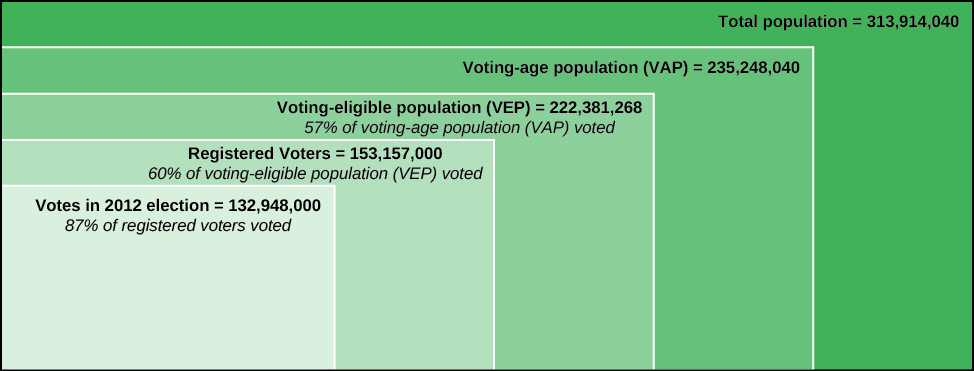| << Chapter < Page | Chapter >> Page > |
An even smaller group is the
voting-eligible population (VEP), citizens eighteen and older who, whether they have registered or not, are eligible to vote because they are citizens, mentally competent, and not imprisoned. If a state has more stringent requirements, such as not having a felony conviction, citizens counted in the VEP must meet those criteria as well. This population is much harder to measure, but statisticians who use the VEP will generally take the VAP and subtract the state’s prison population and any other known group that cannot vote. This results in a number that is somewhat theoretical; however, in a way, it is more accurate when determining voter turnout.
The last and smallest population is registered voters, who, as the name implies, are citizens currently registered to vote. Now we can appreciate how reports of voter turnout can vary. As [link] shows, although 87 percent of registered voters voted in the 2012 presidential election, this represents only 42 percent of the total U.S. population. While 42 percent is indeed low and might cause alarm, some people included in it are under eighteen, not citizens, or unable to vote due to competency or prison status. The next number shows that just over 57 percent of the voting-age population voted, and 60 percent of the voting-eligible population. The best turnout ratio is calculated using the smallest population: 87 percent of registered voters voted. Those who argue that a healthy democracy needs high voter turnout will look at the voting-age population or voting-eligible population as proof that the United States has a problem. Those who believe only informed and active citizens should vote point to the registered voter turnout numbers instead.

Political parties and campaign managers approach every population of voters differently, based on what they know about factors that influence turnout. Everyone targets likely voters, which are the category of registered voters who vote regularly. Most campaigns also target registered voters in general, because they are more likely to vote than unregistered citizens. For this reason, many polling agencies ask respondents whether they are already registered and whether they voted in the last election. Those who are registered and did vote in the last election are likely to have a strong interest in politics and elections and will vote again, provided they are not angry with the political system or politicians.
Some campaigns and civic groups target members of the voting-eligible population who are not registered, especially in states that are highly contested during a particular election. The
Association of Community Organizations for Reform Now (ACORN), which is now defunct, was both lauded and criticized for its efforts to get voters in low socio-economic areas registered during the 2008 election.

Notification Switch
Would you like to follow the 'American government' conversation and receive update notifications?